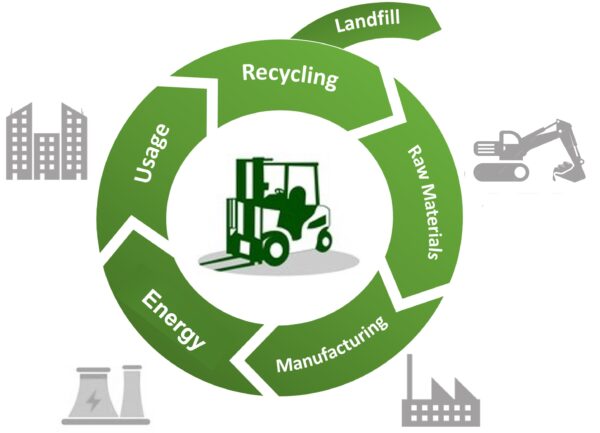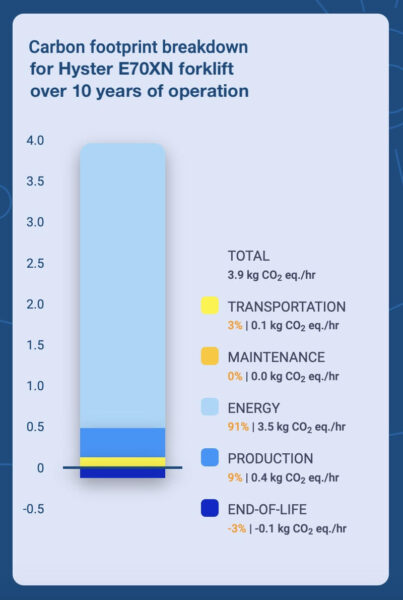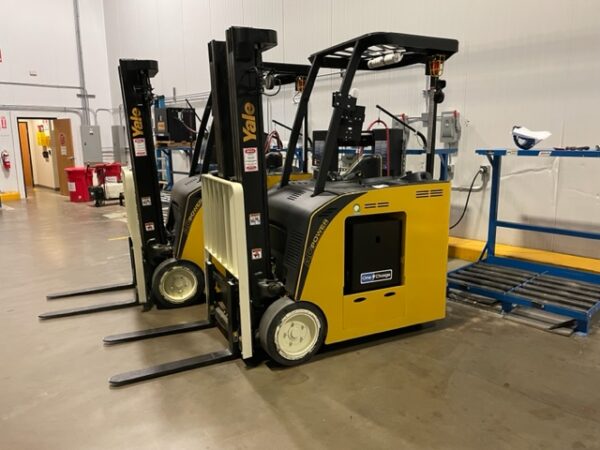Green Logistics
The logistics and transport sector (operating commercial and industrial trucks and forklifts) contributes just over a third of global carbon dioxide (CO2) emissions, making it the largest-emitting sector in numerous developed countries. And that share keeps growing. We are relatively well-informed about the cradle-to-grave CO2 emissions of passenger cars. Even though battery-powered industrial trucks have a 70% share of the US market, there is little information about the carbon footprint of electric forklifts in terms of a full life cycle analysis (LCA). We will address this gap in this article.
While passenger EVs are idle 95% of the time, forklifts are moving loads throughout 2–3 work shifts, up to 20 hours a day! High utilization of electric equipment drives up the share of emissions from the use of electric energy (Scope 2) to over 90%, even with zero tailpipe emissions (Scope 1). Emissions from the manufacturing of both a forklift and a battery (Scope 3) account for an estimated 9% of its total carbon footprint.
LCA of Electric Forklift Carbon Emissions
 Electric industrial trucks offer several environmental benefits and can significantly reduce the carbon footprint of warehouses and distribution centers. However, these operations are not net-zero just yet, and the US companies are required by law to track and report their emissions.
Electric industrial trucks offer several environmental benefits and can significantly reduce the carbon footprint of warehouses and distribution centers. However, these operations are not net-zero just yet, and the US companies are required by law to track and report their emissions.
The total sum of emissions from any vehicle comes from the three main categories:
- tailpipe emissions (Scope 1, a direct result of operating the equipment), zero in the case of electric forklifts;
- emissions from the generation of energy used by a vehicle (Scope 2), in our case—electricity;
- emissions from the manufacturing of the industrial truck (Scope 3), including manufacturing of the battery, mining, and refining of key components (steel, copper, battery metals, plastics, etc.).
It’s the Law!
The United States requires facilities that emit at least 25,000 metric tons of carbon dioxide (CO2) per year to report greenhouse gas emissions to the Environmental Protection Agency (EPA). This requirement to report Scope 1 emissions has been in place since 2009.
California’s Senate Bill 253, known as the Climate Corporate Data Accountability Act, requires companies with over $1 billion in annual revenue to publicly report their Scope 1, 2, and 3 greenhouse gas (GHG) emissions starting in 2026 (for 2025). This is pivotal, as scope 3 emissions often account for more than 90% of an organization’s climate impact and are notoriously difficult to measure.
The bill stipulates that companies will have to submit emissions calculations to a digital reporting platform, and they must make disclosures easily comprehensible to residents, investors, and other stakeholders. They will also be required to hire independent auditors to verify their reported emissions.
It will take time, but chances are that this practice will eventually be adopted in the rest of the USA.
Energy Use
With zero tailpipe emissions, electric forklifts are a more sustainable alternative to their fossil fuel counterparts. However, it is important to recognize that their environmental impact extends beyond just the operational phase. CO2 emissions from the production of electric power used by forklifts represent the lion’s share of their total CO2 footprint. With passenger EVs, manufacturing of the car and the battery reaches 34% of the total emissions (calculated for a 16-year lifespan or 160,000 miles), and energy use adds the other 66%. According to the model used by the European Rental Association, generating the electric energy to charge a forklift’s battery exceeds 90% of its total carbon footprint (calculated for a 10-year lifespan).
Both calculations are based on the average CO2 emissions from electricity-generating plants in the US, but the reality is more nuanced. Ten percent of the electricity generated in the US in 2023 comes from renewable sources, and power plants that still rely on fossil fuels differ dramatically: coal generates about twice the amount of CO2 as natural gas does. California and Texas have massively increased the share of renewables in their energy portfolio, while Arkansas still gets over 35% of its electric power from burning coal. The bottom line is that a forklift’s carbon footprint will differ dramatically from state to state, depending on the technology of electricity generation.
Steel
 Another part of the CO2 footprint associated with forklifts comes from the manufacturing stages. Both the forklift itself and the battery used as its power source require resources and energy, and involve high emissions-generating processes, from mining and refining raw materials to assembling various components.
Another part of the CO2 footprint associated with forklifts comes from the manufacturing stages. Both the forklift itself and the battery used as its power source require resources and energy, and involve high emissions-generating processes, from mining and refining raw materials to assembling various components.

We based our calculations on the specifications of a Hyster E70XN electric forklift with a chassis-integrated lithium battery. The total truck weight without a battery is 7500 pounds, at least 7000 pounds (roughly 3.5 tons) of which is steel.
Globally, producing steel generates as much as 9 % of human-caused CO2 emissions every year—more than any other heavy industry, including cement and chemical production. Typically, integrated (coal-burning) steelmaking generates nearly 2 metric tons of CO2 emissions for every metric ton of steel produced.
However, about 70 percent of America’s steel today is made in over 100 electric-arc furnaces, while roughly 30 percent of steel is produced in integrated mills. In the rest of the world, the story plays out in reverse: About 70 percent of global steel production is made in coal-hungry furnaces, while 30 percent comes from melting scrap metal.
When it comes to curbing CO2, scrap-based steelmaking has a clear advantage. According to the Steel Manufacturers Association 2022 report, America’s electric-arc furnaces generate about 0.37 metric tons of CO2 for every 1 metric ton of crude steel they produce, or roughly three-quarters less than primary steelmaking.
Recycling and Repurposing
Lastly, the disposal of electric forklifts at the end of their life cycle must be managed responsibly to minimize their environmental impact. Fortunately, many manufacturers and industry organizations have established recycling and battery repurposing programs. By participating in these programs, companies can actively contribute to reducing the environmental impact of electric forklifts throughout their life cycle, and the model we used shows a 2% reduction of the total emissions with an average “best practice” approach to recycling.
LCA of Electric Lithium Battery-powered Forklift CO2 Footprint
We used the European Rental Association CO2 calculator to estimate the total footprint of a Hyster E70XN model of an electric lithium industrial truck. The calculations are based on 10 years of operation with a high level of equipment utilization at 2500 hours per year. The total electric forklift carbon footprint came up at 97.5 tons of CO2 equivalent, as a sum of:
- energy use—87.5 tons of CO2 equivalent
- manufacturing (battery + vehicle)—10 tons of CO2 equivalent
- transportation (getting the forklift to its operating facility) is compensated for by recycling and battery repurposing efforts.
Conclusion
Electric forklifts offer a greener, more sustainable alternative to traditional diesel-powered forklifts. By eliminating tailpipe emissions and reducing noise pollution, these vehicles can significantly improve the environmental conditions within warehouses and distribution centers.
Taking a comprehensive approach to evaluating the environmental impact of forklifts is essential. Businesses will soon be required to report not only the direct emissions from operations but also from the electricity generation used to power their forklifts and the emissions generated during the manufacturing of these forklifts.
Since over 90% of the total carbon footprint of forklifts comes from energy generation, efforts to reduce their total GHG emissions should focus on procuring cleaner electricity, improving the energy efficiency of operations, and exploring ways to add power generation from renewable sources, like solar and wind power plants.
About the Author:
Max Khabur is a Director of Marketing at OneCharge, one of the US leading manufacturers of lithium industrial batteries, and a Chairman of the Advanced Energy Council, representing a group of companies – members of the MHI.org (Materials Handling Industry) Association.











